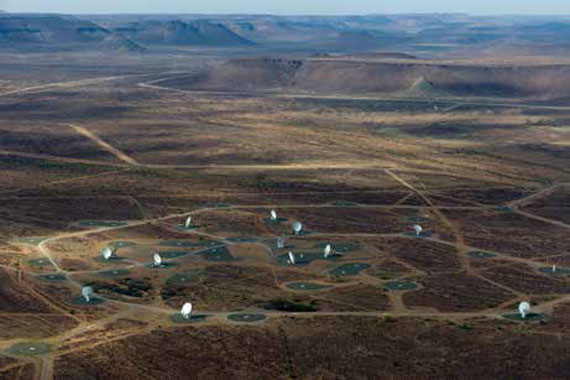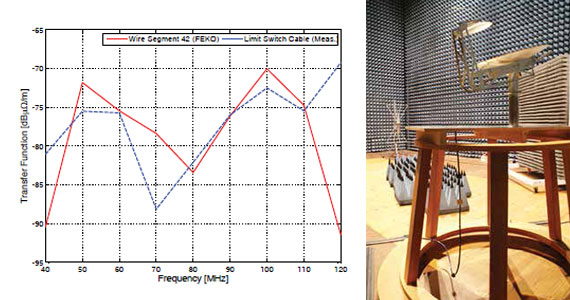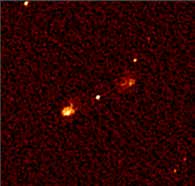It will be constructed in two phases: Phase 1 (SKA1) is estimated to be completed in 2023 and is being built in South Africa and Australia. Phase 2 (SKA2) will be started after SKA1.
In Phase 1 of the project, currently under way, South Africa will host 200 parabolic antennas similar to, but much larger than, a standard domestic satellite dish. They will operate in a frequency range of 350 MHz to 14 GHz with a collecting area of 33,000 square meters. Australia will host more than 100,000 dipole antennas, which resemble TV aerials. Operating in a frequency range of 50 MHz to 350 MHz, they will have a collecting area of 0.4 square kilometers.
What makes the SKA so powerful is its collecting area and the greater sensitivity to detect even very weak cosmic radio signals. The SKA Organization, Manchester, UK, points out that a collection of antennas spread over longer distances means that the images made will have finer resolution than is possible with a single antenna.
The radio telescopes, however, are very sensitive instruments. They must be located as far away as possible from man-made electronics or machines that emit radio waves which can interfere with the faint radio signals coming from the Universe.
The University of Stellenbosch, South Africa — one of five universities awarded research chairs relevant to the SKA project — is exploring electromagnetic (EM) systems and electromagnetic interference (EMI) under the auspices of the Department of Electrical and Electronic Engineering. The chair, headed by Professor David Davidson, includes work by full-time academic staff and more than 20 post-graduate students and post-doctoral students.
Dr. Gideon Wiid, a member of the Department of Electrical and Electronic other researchers in investigating electromagnetic compatibility (EMC) metrology issues for the SKA. The team focuses on the analysis of both EM systems and the mitigation of radio frequency interference (RFI) between systems. The use of sophisticated simulation software enables them to provide RFI mitigation recommendations to SKA South Africa (SA).
While the SKA is under construction, “precursor” and “pathfinder” telescopes are being incorporated into the project. In South Africa, for example, the Karoo Array Telescope (KAT), initially conceived to consist of 20 receptors, currently is comprised of seven receptors and is known as the KAT-7. When the South African government increased the budget to allow the building of 64 receptors, it was renamed “MeerKAT,” for “more of KAT.” MeerKAT is a precursor to the SKA telescope and will be integrated into the mid-frequency component of SKA Phase 1.
Getting to the Right Design

Danie Ludick, a post-doctoral researcher at the University of Stellenbosch in South Africa, works on projects related to the Square Kilometre Array (SKA), the world’s largest radio telescope destined to observe the Universe’s pulsars and black holes, test gravity and look for signatures of life.
One of the challenges in designing the SKA is its size. The structure is massive in terms of the wavelength. In addition, the structure is required to operate at such specific levels that it is extremely sensitive. Make one mistake, and the structure will not work.
To ensure optimum operation, Ludick iterates multiple simulations to ensure the right design. FEKO® software from Altair and its high-performance computing (HPC) capabilities are playing a significant role in assisting researchers so that they have confidence in their designs.
Ludick explains that the simulations are run in an HPC environment. To accelerate these simulations, he uses other products from Altair HyperWorks®, such as PBS Professional®, a workload manager and job scheduler.
Recently, Ludick has been getting more involved in the field of multiphysics. Because the SKA dish structures are standing in the desert, the operating conditions are extreme. In addition to employing FEKO, Ludick has access to other tools in the HyperWorks suite, including the mechanical analysis offered by OptiStruct®. “This guides us into what type of deformations we can expect,” he says.
Signal Sensitivity
The MeerKAT telescope is an extremely sensitive instrument, explains Wiid. Everyday items such as cell phones, laptops and cameras are not allowed on the MeerKAT site because the RFI signals they emit can damage the front end of the receiver, rendering it useless as a scientific tool. Even construction activities — including welding, machinery operation and the use of certain lights — can emit RFI signals.
Wiid and his team are currently investigating RFI monitoring and “direction finding” (locating the source of potentially harmful signals). Wiid says, “You need to be able to monitor what is happening in real time.”
The antenna that is currently installed for RFI monitoring operates between 150 MHz to 4 GHz, a very wide band. A postdoctoral student on the team is working on a slightly smaller antenna that operates beyond 4 GHz. Another student specializing in RFI direction finding is researching an alternative design to Wiid’s antenna. Using simulation tools, this student is getting a frequency range of 150 MHz to 15 GHz.
“It’s pushing the limits of the bandwidth the antennas can cover,” says Wiid. “The only other areas where you get these types of designs is in ultra-wide band radars and high-power impulse testing. It’s not easy to develop an antenna with such a wide range, so we have come quite far in the design — and what we were aiming for.”
The advantage of a larger bandwidth is a clearer signal of what is received in time. If the antenna is not good, the signal is warped. Then, it becomes difficult to distinguish if the signal is from a welder, cell phone or laptop. “If you get a clean signal in time,” says Wiid, “you can more easily distinguish it and start doing calculations with that data to determine the cause of the interference.”
Right-on-Target Research
Wiid has spent the last couple of years conducting RFI mitigation research and shares the results of one of his projects. He explains that the proximity of adjacent antennas and other systems can result in unwanted inter-coupling, due to currents on cables. The inter-coupling needs to be minimized by first identifying the coupling mechanisms, either through simulations or measurements, and then applying approaches to improve isolation, for example shielding or rerouting the cables.
However, on-site RF coupling investigations can only be done after installation. During the design, planning and installation stages, such characterization of the EM environment has to be done on scale models and through simulations.
Wiid and his team did just that. For the actual MeerKAT telescope, on-site RFI measurements were collected using an emission reference source (ERS) that operates from 30 MHz to 1,000 MHz. The ERS was placed 30 meters from the dish to represent any possible RF coupling from a future nearby telescope.

Radio Telescope Components
A radio telescope is made up of an antenna, receivers and a digital back-end (data recorder). The antenna is used to collect the incoming radio waves while the receiver and amplifier boost weak radio signals to measurable levels.
The SKA will feature three main telescope types: dishes, low-frequency antennas and mid-frequency antennas. Dishes for the SKA are planned to be made from metal, with high accuracy in their shape, and will be capable of withstanding high winds and intense thermal and environmental stresses.
Low- and medium-frequency telescopes have aperture arrays comprised of a large number of small radio wave receptors arranged on the ground. Radio signals are captured when they first hit the receptor on the ground. The signals from all the elements are then added together electronically, in phase, to synthesize antenna arrays.
An aperture array is a large number of small, fixed antenna elements coupled to appropriate receiver systems, which can be arranged in a regular or random pattern on the ground. These aperture array antennas provide a large field of view and are capable of observing more than one part of the sky at once. As such, the system will be able to look at multiple regions of the sky simultaneously, greatly increasing the telescope survey speed.
Researchers created a physical, simplified, 1/20th scale model of the initial MeerKAT dish design to test in an anechoic chamber (one that absorbs reflection of sound and microwaves). In addition, the scaled design was imported from the mechanical design software into FEKO, the simulation software from Altair. FEKO is used in applications including antenna design and placement, scattering, radar cross section, and EM compatibility (EMC).
The electrical size of the structure and the broad spectrum covered required significant computational resource requirements. FEKO’s state-of-the-art, parallel, “method of moments” solver was run on a supercomputer at the Centre for High Performance Computing (CHPC) in Cape Town in a matter of days.
According to Wiid, the measured and simulated results of the transfer function — a measure of the coupling between the RF source and a receiver — agreed very well. This validated FEKO model was then used to perform rigorous RFI studies and make design, layout, shielding and bonding recommendations to mitigate the interference between these extremely sensitive telescopes.
Wiid says, “FEKO modeling on the Cape Town CHPC has been pivotal in our RFI mitigation research at Stellenbosch University for the MeerKAT Telescope. We have successfully validated dish-scale models with measurement and continue to study EM induced current paths and provide RFI mitigation recommendations to SKA SA.”
 A team of researchers and students from the University of Stellenbosch collects measurements on a scale model of the MeerKat antenna inside an anechoic chamber to study electromagnetic compatibility issues (top). Results from physical tests are then compared with FEKO simulations.
A team of researchers and students from the University of Stellenbosch collects measurements on a scale model of the MeerKat antenna inside an anechoic chamber to study electromagnetic compatibility issues (top). Results from physical tests are then compared with FEKO simulations.
Investing in the Future
South Africa became involved in the SKA project in 2001, initially as an observer. Today, it is engaged in world-class scientific research and cutting-edge technology development. What’s more, the SKA project is fueling development of future scientists, engineers and technicians.
For example, the SKA SA Project has provided more than 700 grants to postdoctoral fellows and postgraduate and undergraduate students working on science and engineering degrees. In addition, grants have been awarded to students training to be technicians. This effort has increased the number of highly skilled people available to the general economy in South Africa and the region.
According to Wiid, part of the success — and innovation — surrounding the SKA project lies in the enthusiasm of these young professionals and their ability to think “outside of the box.” He says, “South Africa is young in the radio astronomy field, so there are a lot of young people who are enthusiastic for the project. You get new ideas…They face challenges and say, ‘Let’s do something about it.’”
He points to the RFI monitoring antennas currently under design. One of the challenges the team faced was in constructing the large antennas. The cost to machine them was prohibitive. Wiid explains that the team decided to 3D print the antennas and use aluminum paint as conductive coating. “We now have antennas,” he says, “that are extremely inexpensive to manufacture and that enable us to prove our principles. And, we have gotten excellent designs.”
While a great deal has already been accomplished on the MeerKAT project, there is still much work to be done. SKA SA expects engineering verification on 32 receptors to be completed by the end of this year, with science commissioning scheduled for completion by the end of March 2017. By the end of next year, engineering verification and science commissioning should be finished on 64 antennas. Between 2018 and 2023, construction of SKA Phase 1 will take place. Construction of SKA Phase 2 will take place between 2023 and 2030.
For more information on MeerKAT, visit http://ska.ac.za/index.php.
Beverly A. Beckert is Editorial Director of Concept To Reality.
A Look at MeerKAT

The MeerKAT telescope will be an array of 64 interlinked receptors (comprised of the complete antenna structure, with the main reflector, sub-reflector and all receivers, digitizers and other electronics installed).
Each MeerKAT receptor consists of three main components: the antenna positioner, which is a steerable dish on a pedestal; a set of radio receivers; and a set of associated digitizers.
In July 2016, an observation using just 16 of the eventual 64 dishes produced a view of the sky (pictured above) revealing more than 1,300 galaxies in the distant Universe, compared to 70 known in the same location prior to MeerKAT. Professor Justin Jonas, SKA South Africa chief technologist, says, “Based on the results shown, we are confident that after all 64 dishes are in place, MeerKAT will be the world’s leading telescope of its kind until the advent of SKA.”
Dr. Rob Adam, project director of SKA South Africa, says, “Through MeerKAT, South Africa is playing a key role in the design and development of technology for the SKA. The South African team of more than 200 young scientists, engineers and technicians, in collaboration with industry, local and foreign universities and institutions, has developed the technologies and systems for MeerKAT. These include cutting-edge telescope antennas and receivers, signal processing, timing, telescope management computing and data storage systems, and algorithms for data processing.”